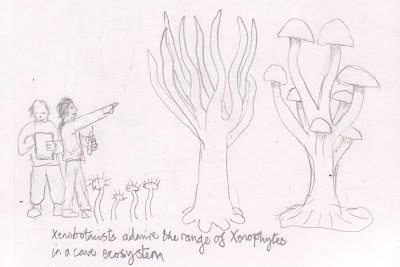Native Life Forms
There has been life on Rogue Planet long before humans crash-landed in their starships. To describe them as aliens would be to forget what planet we are looking at - if these life forms arrived on Earth, yes they would be aliens then. But here on Rogue Planet they are the native life forms, and not all of them appreciate the human colonial presence - as far as they are concerned, humans are the alien invaders.
It is believed that life formed on Rogue Planet over a billion years ago while it was still orbiting a star. It started on the surface, and when Rogue Planet found itself without a star those that stayed on the surface went extinct due to extreme cold. Those that migrated underground and evolved to fit a subterranean lifestyle have survived and in some cases prospered. Human scientists from the colonial cities have had a go at classifying the major groups. Scientists have noted that native life forms have similar metabolisms to Earth life, using carbon and water to create sugars, proteins and lipids, but use different nucleotide bases in their DNA so any tissue or blood sample will show whether the source is native or terrestrial. Since native life forms use the same basic chemistry they also require Earth-like temperatures and an oxygen-rich atmosphere. This shared environment means that native life and colonial humans will inevitably come into contact.
The Equivalent of Plants - the Xenophytes
One of the most prolific and also diverse groups is the exo-kingdom called the Xenophytes. These are generally rooted in one place and spread by seeds and spores rather than getting up and moving around. They seem to have formed a symbiotic relationship with bacteria that can harness previously unknown forms of radiation, known as theta radiation. This provides them with the energy they need to turn carbon dioxide in the subterranean atmosphere into more complex carbon compounds such as sugars and starch. This means they fulfil a role very similar to Earth’s green plants that use sunlight rather than theta radiation for similar processes (photosynthesis). It is worth noting that a lot of these Xenophytes will emit light as a byproduct of their metabolism, so many habitats with xenophyte growths will be gently illuminated by their phosphorescent glow.
The Squidgies - Rogue Planet's molluscs
These are animals that do not have hard skeletons, and as such they seem similar to worms, sea anenomes and some molluscs such as slugs and octopi.
The Chitons - The insectoids of Rogue Planet
These animals come in a wide range of sizes, from near-microscopic (flea-sized) to gargantuan monsters weighing several tons. They all have chitinous exoskeletons and more than four limbs, and as such are most similar to Earth’s arthropods, particularly insects and crustaceans.





Comments
Post a Comment